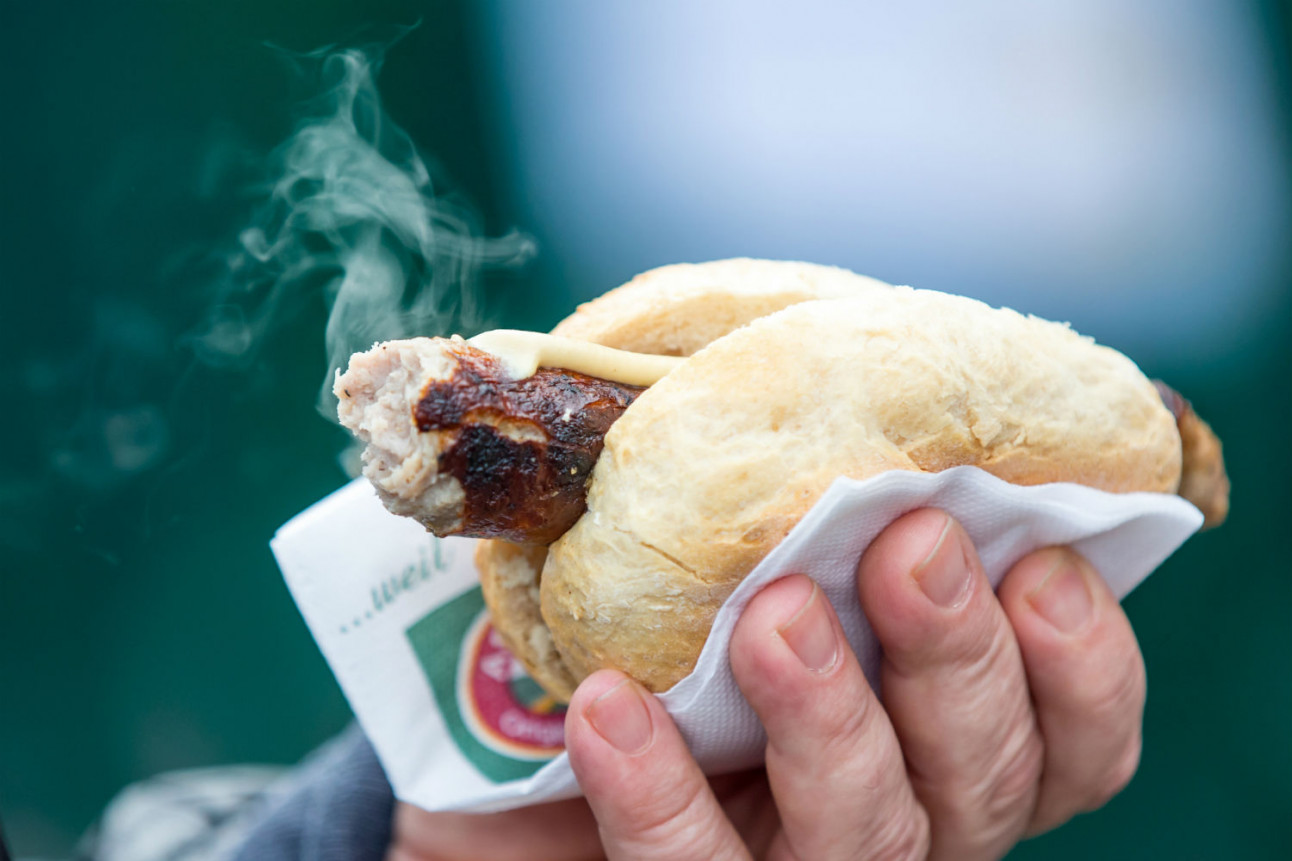Grilling in Germany: What you need to know about the Bratwurst

Whether it’s at a football game, at the carnival or at the town fair - the Bratwurst has become a culinary staple in Germany. But something’s cooking - nowadays, even vegetarians and vegans can their Bratwurst fix.
Red-hot coals and the sizzle of fat as it drips onto the grill - the arrival of summer in Germany marks the start of barbecue season. There’s one fixture of barbecue culture that simply cannot go amiss: the Bratwurst.
There are 150 unique types of Bratwurst with textures varying from coarse to fine, explains Uwe Keith, the chairman of the “Friends of the Thuringian Bratwurst” association.
In a bid to uncover the history of the Bratwurst, the association consulted around 200 historical written sources.
According to their findings, the Bratwurst was first mentioned in 1404 in an invoice taken from a monastery, meaning it must already be over 600 years old.
READ ALSO: The Local's meaty vegan guide to Berlin
It is also very popular in the USA, so much so that the word “Bratwurst” has made its way into everyday use.
It also enjoys its own place on the American culinary calendar, with August 16th marking National Bratwurst Day - a day which is also, of course, celebrated in Germany.
As well as cult favourites such as the Thuringian and Nuremberg Rostbratwurst, you’re much more likely to spot vegetarian and vegan alternatives on the barbecue these days.
According to Proveg Deutschland (the German Vegetarian Association), Americans spent $159 million (around €134.13 million) on plant-based Bratwursts last year, a 40 percent increase compared to 2018. There are currently no reliable figures concerning the sale of Veggie-Bratwursts in Germany.
READ ALSO: Quiz: How well do you know German food culture?
From the Currywurst to the Nuremberg, Thuringian and ham varieties - meat substitutes for the Bratwurst are available in all imaginable forms. According to Proveg, peas, wheat, oats, soya and lupines are the most popular alternatives amongst manufacturers.

A classic Bratwurst from Thuringia. Photo: DPA
More is known, however, about centuries-old meat-based variety. According to data from the German Butchers Association (DFV), the average German ate three kilograms of meat-based Bratwurst in 2018.
They are also becoming increasingly popular with consumers: in 1990, Bratwursts accounted for just 4.3 percent of all meat and sausage product sales. By 2018 this figure had more than doubled to 9.1 percent.
READ ALSO: Can I have a barbecue on my balcony in Germany?
Pork is the meat most frequently used by butchers, followed by beef, lamb and poultry, explains DFV food technologist Axel Nolden.
One of the most popular variants is the Thuringian Rostbratwurst, seasoned with distinctive spices such as Marjoram. According to Nolden, there are significant regional differences between the various types of Bratwurst.
Only the top dogs of the Bratwurst world - the Nuremberg and Thuringian Rostbratwurst - benefit from any degree of geographical protection.
When defining the precise parameters of so-called “Protected Geographical Indication”, the Federal Ministry for Food and Agriculture explained that “at least one stage of the production process has to take place in the area of origin, even though raw ingredients needed to make the sausage can come from other regions”.
READ ALSO: Fear not, eat Bratwurst, says German food minister
Though they may be loved by many, Bratwursts are best enjoyed in moderation to maintain a healthy lifestyle.
“The Bratwurst has a very high salt and fat content”, said Antje Gahl of the German Nutrition Society (DGE). 150 grams (ie. one portion) constitutes around half of the recommended daily fat intake (60 to 80 grams), and makes up almost a third of the recommended daily energy intake. The DGE has no data concerning meat-free alternatives.
Caution is also advised when preparing Bratwursts. Regardless of whether it is fried or grilled, Gahl warns that carcinogenic substances can form on foods cooked to the “well-done” stage. The DGE therefore advises that Bratwürste should be cooked with care.
Translated by Eve Bennett.
Comments
See Also
Red-hot coals and the sizzle of fat as it drips onto the grill - the arrival of summer in Germany marks the start of barbecue season. There’s one fixture of barbecue culture that simply cannot go amiss: the Bratwurst.
There are 150 unique types of Bratwurst with textures varying from coarse to fine, explains Uwe Keith, the chairman of the “Friends of the Thuringian Bratwurst” association.
In a bid to uncover the history of the Bratwurst, the association consulted around 200 historical written sources.
According to their findings, the Bratwurst was first mentioned in 1404 in an invoice taken from a monastery, meaning it must already be over 600 years old.
READ ALSO: The Local's meaty vegan guide to Berlin
It is also very popular in the USA, so much so that the word “Bratwurst” has made its way into everyday use.
It also enjoys its own place on the American culinary calendar, with August 16th marking National Bratwurst Day - a day which is also, of course, celebrated in Germany.
As well as cult favourites such as the Thuringian and Nuremberg Rostbratwurst, you’re much more likely to spot vegetarian and vegan alternatives on the barbecue these days.
According to Proveg Deutschland (the German Vegetarian Association), Americans spent $159 million (around €134.13 million) on plant-based Bratwursts last year, a 40 percent increase compared to 2018. There are currently no reliable figures concerning the sale of Veggie-Bratwursts in Germany.
READ ALSO: Quiz: How well do you know German food culture?
From the Currywurst to the Nuremberg, Thuringian and ham varieties - meat substitutes for the Bratwurst are available in all imaginable forms. According to Proveg, peas, wheat, oats, soya and lupines are the most popular alternatives amongst manufacturers.

A classic Bratwurst from Thuringia. Photo: DPA
More is known, however, about centuries-old meat-based variety. According to data from the German Butchers Association (DFV), the average German ate three kilograms of meat-based Bratwurst in 2018.
They are also becoming increasingly popular with consumers: in 1990, Bratwursts accounted for just 4.3 percent of all meat and sausage product sales. By 2018 this figure had more than doubled to 9.1 percent.
READ ALSO: Can I have a barbecue on my balcony in Germany?
Pork is the meat most frequently used by butchers, followed by beef, lamb and poultry, explains DFV food technologist Axel Nolden.
One of the most popular variants is the Thuringian Rostbratwurst, seasoned with distinctive spices such as Marjoram. According to Nolden, there are significant regional differences between the various types of Bratwurst.
Only the top dogs of the Bratwurst world - the Nuremberg and Thuringian Rostbratwurst - benefit from any degree of geographical protection.
When defining the precise parameters of so-called “Protected Geographical Indication”, the Federal Ministry for Food and Agriculture explained that “at least one stage of the production process has to take place in the area of origin, even though raw ingredients needed to make the sausage can come from other regions”.
READ ALSO: Fear not, eat Bratwurst, says German food minister
Though they may be loved by many, Bratwursts are best enjoyed in moderation to maintain a healthy lifestyle.
“The Bratwurst has a very high salt and fat content”, said Antje Gahl of the German Nutrition Society (DGE). 150 grams (ie. one portion) constitutes around half of the recommended daily fat intake (60 to 80 grams), and makes up almost a third of the recommended daily energy intake. The DGE has no data concerning meat-free alternatives.
Caution is also advised when preparing Bratwursts. Regardless of whether it is fried or grilled, Gahl warns that carcinogenic substances can form on foods cooked to the “well-done” stage. The DGE therefore advises that Bratwürste should be cooked with care.
Translated by Eve Bennett.
Join the conversation in our comments section below. Share your own views and experience and if you have a question or suggestion for our journalists then email us at [email protected].
Please keep comments civil, constructive and on topic – and make sure to read our terms of use before getting involved.
Please log in here to leave a comment.